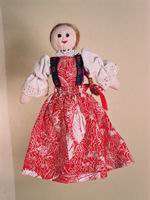Eva Pančuhová
Textile dolls, also known as rag dolls, were known all over Slovakia. In the folk environment children played with several types of textile dolls made for them by their parents or older siblings, or the children made them themselves. The end result depended on their possibilities, creativity and patience. The basis for the simplest textile dolls was a rug with a knot tied in one corner to create a doll’s head. Only a few were preserved from this type because they easily became damaged due to extensive use or, possibly, because children would not easily give them up and kept them as a memory of their childhood. Therefore, it is not possible to see them frequently in our museums. A more sophisticated type of textile dolls had the individual parts made separately, and these were dressed in clothes made from textile scraps. This type is the most frequently found in museum collections. Their production in 1930s became part of everyday teaching in basic schools. They differ by the clothes, resembling the style of clothing in the region where the doll was made. Significantly better quality, industrially produced textile dolls showed up in Slovakia between the end of the 19th and beginning of the 20th centuries. In 1900, the Živena women’s group prepared and presented at a large exhibition of folk dolls in Prague a collection of Slovak textile dolls dressed in traditional costumes from individual Slovak regions. The industrial production of dolls made from natural rubber or celluloid gradually caused textile dolls to disappear from the toy market. They also started dressing them in traditional regional costumes. However, these dolls are not considered traditional children toys.
